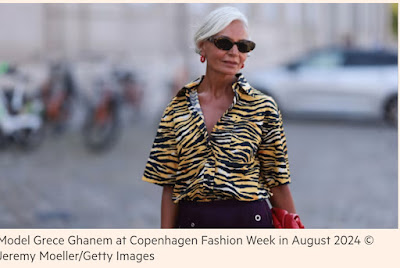Haircare labels that put the glamour into grey
As brands capitalise on a trend for women to embrace grey hair, a wave of new products brings a chic edge to ‘growing old gracefully’
“I don’t know why more women don’t talk about how fun it is to be grey,” says Maayan Zilberman, a New York-based artist and candy designer who stopped dyeing her hair black during the Covid-19 lockdowns and now sports a full head of variegated grey locks. “Having silver hair feels like having the blonde hair I always wanted.”
In 2025, many women are finding they no longer consider grey hair a trait to cover or conceal, but rather a feature to embrace. Which is why Zilberman finds it mystifying that the growing ranks of women with silver hair aren’t being better served by beauty brands: “The hair industry really needs to catch up.”
Well, the catch-up is afoot. Last August, Silverist, a standalone brand for women keen to make the most of their grey hair, was launched in the US. For beauty industry veteran Evelyn Wang, who has worked at businesses such as Estée Lauder companies and L’Oréal Paris, silver-specific haircare is a personal issue. She went grey in her twenties and dyed her hair for more than 20 years. “Towards the end, I was box-dyeing my hair every 10 days,” she says. “I had to see if there was another way to live with my hair.” She spent two years highlighting and grey-blending her hair before she reached a point where she was satisfied with her natural colour.
This was a decade ago, before finding that advice was as simple as typing #ditchthedye or #silversisters into an Instagram search bar. “If you Googled grey hair, there would just be a bunch of articles about how to keep your stubborn greys from showing up. There was very little information about taking care of your greys, and there really wasn’t a lot of product.”
Having spent her career in the beauty industry, Wang knew “it was rare to find a white space, or in this case a silver-grey space.” She started thinking about incubating the brand in 2019, filed for trademarks in 2022 and spent two years on product development. She launched the brand with three products: a shampoo, a conditioner and a leave-in serum.
“Grey hair is a hair type with distinct needs and differences from pigmented hair,” Wang says. “It can be porous, drier and more brittle, so it requires hydration to stay smooth and soft. It can stain yellow due to heat damage, so heat-protective ingredients are key. It can go brassy, so the shampoo includes a gentle buildable toner.” Wang says her formulas offer moisture, brightness, shine, smoothness, manageability, scalp care and heat protection bundled up in three products.
Elsewhere, hair stylists and brands including Oribe, Davines and L’Oréal have reported increased demand for silver-specific products with names such as Silverati (Oribe) and Alchemic Silver Shampoo (Davines). According to a spokesperson at Oribe, the pandemic shifted the market and demand has persisted as more consumers embrace their natural hair colour and texture.
It’s an area of growing interest more broadly, with a Mintel hair colour market report from 2023 showing that 66 per cent of consumers who colour their hair believe people should embrace natural greys (even if they don’t want to do so themselves — at least not yet).
“Absolutely, the attitude toward silver hair has changed dramatically in recent years,” says Jack Martin, the California-based celebrity hair colourist who looks after Andie MacDowell and Jane Fonda’s greys. He has a six-month waiting list for silver transformation appointments (and an Instagram feed filled with engrossing “before” and “after” photos @jackmartincolorist). “I see it as luxury.”
Lisa Payne, head of beauty at trend forecasting and analysis group Stylus, sees the elevation of silver hair to a new beauty ideal as part of a current “mature beauty moment” that also includes Brooke Shields’ Commence hair line and Merit’s age-inclusive colour cosmetics. “We’re seeing a shift in consumer perspective on grey hair, from something that they have to cover up to something that they actively want to enjoy,” Payne says.
She adds: “Especially when it comes to haircare, the stuff that seems to be resonating most with the consumers are the products that are promising to let users have their hair journey in the healthiest way possible. So it’s not about a solution. It’s about, ‘let’s give you the chance to look your best, however it is that you want to play it.”
I myself don’t have silver hair, but I do have silver streaks — ones I suppose I’ve “embraced” by way of inertia or procrastination. It took finding Silverist to realise that I’d felt I should do something to cover my greys, when instead I could choose to make the most of them.
Wang’s next step is expansion, via a partnership with a US-wide clean beauty retailer. “Everyone’s going to go grey at some point,” she says. “Whether or not they embrace it is another issue. But I think it’s just a matter of time.”
Wang says that Silverist, while “definitely still a small indie brand,” achieved six figures in sales within its first few months of operations, doubling its own initial forecasts. “It’s really the strength of the community that’s pushing the brand forward,” she says. It helps that as the face and hair of Silverist, Wang hears from so many of her overwhelmingly female customers directly “I feel so much genuine gratitude and sisterhood with these women. I knew the power of this community was there, but wow, they really came out for this.”

